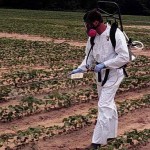
Pesticide-impregnated seeds exterminating friendly insects, animals.
by Ole Hendrickson
Imagine a world in which the most widely used agricultural pesticides indiscriminately killed nearly all insects, including butterflies, beetles and moths.
Suppose that these pesticides were highly soluble in water and readily migrated into soil, where they killed decomposer organisms that maintain soil fertility, such as springtails and earthworms.
The pesticides in question are called neonicotinoids. They interfere with nerve impulse transmission in insects and other animals, leading to strong muscle contractions, neuromuscular destruction and death.
And further suppose that populations of birds, bats, salamanders, frogs, fish, and other animals that feed on insects were crashing in catastrophic fashion.
These aren't suppositions. These are facts. This is the world we live in today.
The pesticides in question are called neonicotinoids. They interfere with nerve impulse transmission in insects and other animals, leading to strong muscle contractions, neuromuscular destruction and death. These powerful nerve poisons, chemically related to the nicotine found in tobacco, have relatively low direct toxicity to humans and other vertebrate animals.
The German chemical giant Bayer introduced neonicotinoids in the mid-1990s to replace pesticides that are more toxic to vertebrates. As systemic pesticides, they have a unique mode of action. Neonicotinoids are used to coat plant seeds, and the toxins spread throughout the plant as it grows. All plant components — leaves, flowers, pollen, nectar, etc — become toxic.
Concerns are mounting that neonicotinoids have turned vast portions of North America and Europe into dead zones for insects and for the birds, bats, frogs, etc that feed on them.
Neonicotinoids are used on corn, wheat, canola, soybeans, barley, and more than 40 fruits and vegetables (tomatoes, broccoli, lettuce, eggplant, potatoes, strawberries, raspberries, apples, etc). They are used on trees, lawns, and ornamental gardens. They are used as seed coatings, sprayed on foliage, and injected into furrows in the soil.
Although neonicotinoids are not fat soluble and do not “bio-magnify” in the food chain, they are persistent. They remain attached to nerve cells for prolonged periods. They accumulate in soil and water. Concerns are mounting that neonicotinoids have turned vast portions of North America and Europe into dead zones for insects and for the birds, bats, frogs, etc. that feed on them.
Neonicotinoids also kill beneficial insect predators that keep pests under control. For example, when New York sprayed elms in Central Park, the result was a major spider mite outbreak. Spraying killed all the insects that fed on the mites, but not the mites themselves.
Evidence is strong that neonicotinoids are a leading cause of colony collapse disorder in honeybees. Native bees are also affected. One of Canada’s formerly most abundant bumblebees is now endangered.
Bayer’s profits from neonicotinoids exceeded $1 billion in 2010. It has supported dozens of studies trying to show their safety. The US EPA recently recognized that some of these studies were badly designed and called for additional research. Canada’s Pest Management Regulatory Agency followed suit.
University of Guelph researchers conducted one of the flawed studies. They put beehives in canola fields planted with neonicotinoid coated seeds, and in fields planted with uncoated seeds. But the fields were too close together, and bees in the “control” fields were foraging in the treated fields.
The European Food Safety Agency issued a report earlier this year confirming the risks of neonicotinoid pesticides to bees. On February 25, 2013 the European Parliament voted on a 2-year ban on use of the three major neonicotinoid pesticides — clothianidin, thiamethoxam and imidacloprid — on crops attractive to bees, including sunflower, canola and corn. The ban would also prohibit sale and use of seeds coated with the three pesticides.
In North America, the neonicotinoid debate is playing out behind the scenes in regulatory agencies, with limited public awareness of this issue. As government officials wait for results of more studies, spraying continues, and populations of birds, bees, frogs, fish, and other animals continue to decline.
© Copyright 2013 Ole Hendrickson, All rights Reserved. Written For: StraightGoods.ca
 Ole Hendrickson is a forest ecologist and current president of the
Ole Hendrickson is a forest ecologist and current president of the
Sorry, the comment form is closed at this time.